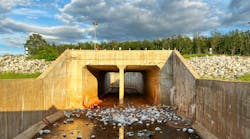Last year, many people in the US suffered from the most costly and common of disasters in the nation—flooding. Fueled by warmer weather, the National Oceanic and Atmospheric Administration (NOAA) reported that 2019 was the wettest on record in the US, with historic flooding taking place across much of the nation.
From March through July, flooding along the Mississippi River and its tributaries—particularly the Missouri—caused an estimated $17 billion in damages. This follows 2017, when the cumulative cost of the nation’s 16 separate billion-dollar-plus weather events was $306.2 billion, breaking the previous record of $214.8 billion in 2005. Not surprisingly, the National Flood Insurance Program, which is supported in part by taxpayers, is more than $20 billion in debt.
Unfortunately, we’ve already experienced major flooding this year in Mississippi and Tennessee, and the National Weather Service predicts more this spring.
It’s time to rethink how we plan and prepare for flooding. While constructed infrastructure like dams and levees will always play an important role, these approaches alone are no longer sufficient for a world where flood and storm events are becoming more frequent, extreme, and costly. Plus, when these protections fail, they fail big, threatening lives and often leading to greater damages to assets and infrastructure, including property and farms.
Instead of working against nature, we must look to it as an essential partner in building resilience for communities and economies. For instance, The Nature Conservancy (TNC) and partners recently produced a study that answers an important question related to flooding: “What would cost American taxpayers more? Paying now to protect undeveloped areas that are likely to flood in the coming decades? Or, allowing development to proceed based on current projections and paying for subsequent flood damages?” The study, published in Nature Sustainability, identified an area roughly the size of Colorado in 100-year floodplains where conservation would be an economically sound way to avoid future flood damages. And for just over 21,000 square miles of this area, the benefits are at least five times the cost, meaning that a dollar invested in floodplain protection today returns at least $5 in savings from avoided flood damages in the future.
Consider that just one acre of wetlands can hold about 1 million gallons of water—more than an Olympic-size swimming pool—reducing impacts on communities during floods. And for every $1 spent on restoring wetlands, more than $7 in direct flood-reduction benefit is achieved.
Nature not only offers us cost-effective defenses against floods, it also can support resilience benefits across a range of sectors. Healthy natural areas help regulate the flow of water and reduce erosion and they are also buffers against the effects of extreme urban heat. Wetlands filter out pollutants, improving water quality. They also recharge aquifers that are critical to agriculture and drinking water for an estimated 38% of the US population. A healthy natural environment also supports wildlife, recreational opportunities, and the outdoor industry.
To improve how our nation addresses floods, we must enable federal agencies, state governments, and local municipalities to increase their investments in natural infrastructure. For instance, Water Resources Development Act legislation from 2016 and 2018 included provisions that allow for levee setbacks, which we hope will be implemented quickly to help avoid future flooding. And the 2020 legislation should include additional policies promoting the use of nature-based solutions to reduce risk. Similarly, there is room in the upcoming highway bill for enabling provisions that advance the use of nature-based solutions that can help communities address infrastructure challenges and become more resilient in the face of storms and floods.
Along with enhancing and reforming infrastructure investments, we must also support the greater use of science to accurately identify areas at risk of flooding. For instance, a recent study by TNC and partners found that 41 million Americans—some 13% of the population—are at risk from flooding rivers. That’s more than three times the current estimate based on regulatory flood maps. Also, less than one-third of our streams, rivers, and coastlines have mapped flood hazard areas, which means there is a significant risk that the location and protection of new development is not guided by flood risk information.
Congress and the Executive Branch should also put in place a federal flood risk reduction consideration similar to that recently passed by Congress for Department of Defense facilities (PL 115-232 Sec 2805), which creates common-sense rules to help protect communities from floods and taxpayers from paying for damages as floods become more intense.
When disasters strike, federal relief funds should be used not only to rebuild the same concrete structures we’ve traditionally relied upon with mixed results, but also to support nature-based solutions that can help keep our nation above water, both literally and financially.
And, of course, we should use science to help guide the investments we make in nature-based solutions. With this in mind, TNC and partners recently developed a Floodplain Prioritization Tool, which helps decision makers—like federal, state, and local governments; county planners; land trusts; and businesses—optimize their floodplain protection and restoration investments and minimize the impacts of development. The tool, which is online at www.FPTool.org, is interactive and GIS-based and designed to help guide investments and assess trade-offs related to different goals, like water quality, wildlife habitat, and estimated flood damages.
Learn more about TNC’s work to reduce flood impacts at www.nature.org/floods.
References
National Oceanic and Atmospheric Association National Weather Service. National Long Range Outlook. https://water.weather.gov/ahps/long_range.php
Johnson, K.A., Wing, O.E.J., Bates, P.D. et al. “A benefit–cost analysis of floodplain land acquisition for US flood damage reduction.” Nature Sustainability 3 (2020): 56–62. https://doi.org/10.1038/s41893-019-0437-5
Wing, Oliver E J; Bates, Paul D; Smith, Andrew M; et al. “Estimates of present and future flood risk in the conterminous United States.” Environmental Research Letters 13, no. 3 (2018). https://iopscience.iop.org/article/10.1088/1748-9326/aaac65
About the Author
Anna Brown
Anna Brown is the climate adaptation director for North America at The Nature Conservancy.


